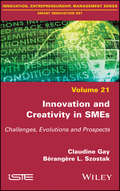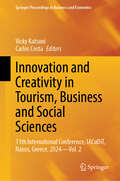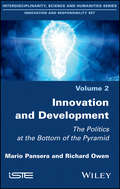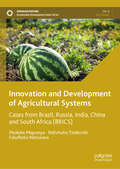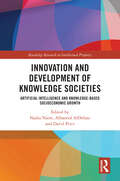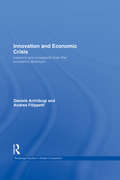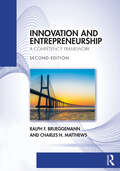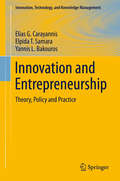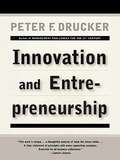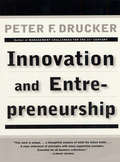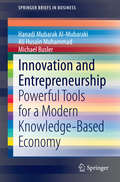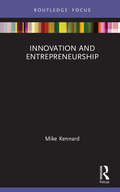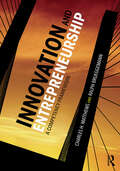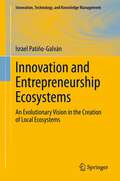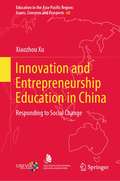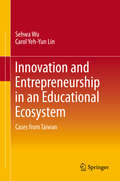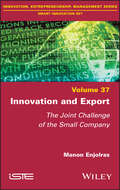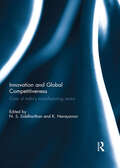- Table View
- List View
Innovation and Collaboration at Merrill Lynch
by Ingrid Vargas Boris GroysbergIn the spring of 2005, Candace Browning, head of Global Securities Research and Economics at Merrill Lynch, led about 500 Merrill Lynch analysts worldwide in a collaborative effort to produce innovative research, most of them accustomed to working independently in their own regions and areas of expertise. Less than five years earlier, research analysts had expressed little or no interest in group efforts. By 2005, many analysts who had been assigned to work on collaborative projects indicated increased learning and a willingness to work in teams again. Some analysts themselves chose to work together. Whereas Merrill had come a long way, some analysts remained skeptical. Managers also questioned whether all types of collaboration were worth the significant efforts required. Browning had to consider the issues involved, the feedback received, and the industry itself and devise a strategy moving forward.
Innovation and Corporate Renewal
by James M. UtterbackThis chapter addresses the perennial management issue of how corporations can renew their technology, products, and processes as a basis for continued competitive vitality.
Innovation and Creativity in SMEs: Challenges, Evolutions and Prospects
by Claudine Gay Berangere SzostakIn order to survive in their market and differentiate themselves from the competition, small- and medium-sized enterprises (SMEs), which represent more than 90% of companies worldwide, need to be creative and innovative. This book presents a conceptual framework for thinking about innovation and creativity in SMEs. It takes into account their strategic relation to their environment and the economic, technological and social changes that they face. Their ability to enhance their creativity with new ideas and to legitimize them during their implementation is also taken into account
Innovation and Creativity in Tourism, Business and Social Sciences: 11th International Conference, IACuDiT, Naxos, Greece, 2024 - Vol. 2 (Springer Proceedings in Business and Economics)
by Vicky Katsoni Carlos CostaThis book is the second volume of the proceedings of the 11th International Conference of the International Association of Cultural and Digital Tourism (IACuDiT). Focusing on &“Innovation and Creativity in Tourism, Business and Social Sciences,&” the conference was held from September 3 to 5, 2024, in Naxos, Greece. The book showcases the latest research on tourism business, technology, and the social sciences and presents a critical academic discourse on ICT adoption in the social sciences, regional development; sustainability and tourism experience; smart and sustainable practices; innovations in museum interpretation and collections management; emerging and disruptive technologies; gaming, gamification and augmented reality, and other topical aspects in business and the social sciences. The book discusses these digital transformation processes from various standpoints, including its effect on the social sciences combined with specific forms of tourism. The impact of digitalization encourages the emergence of new digital products and services based on the principle of flexibility. The book focuses on the knowledge economy and the &“smart destinations&” concepts and highlights new modes of tourism management and development, while further chapters address emerging technologies, such as the Internet of Things, AI, big data, and robotics in a range of tourism practices.
Innovation and Development: The Politics at the Bottom of the Pyramid
by Mario Pansera Richard OwenInnovation, often tempered by the language of inclusion, has become an indispensable element of contemporary development policy and practice in the so-called Global South. Driven by multinational companies, public–private partnerships and social enterprises, “innovation for development” aims to co-produce social goods (things of value) such as poverty alleviation with associated profit through innovative market-led solutions, opening up untapped and unserved markets in the developing world and exploiting the potential “fortune at the bottom of the pyramid”. But innovation for development is a contested notion with the capacity to shelter multiple political agendas. By reviewing existing academic theory and discussing four in-depth case studies from Bangladesh and India, this book interrogates how innovation for development is being framed, its politics and the impacts it is having on rural communities on the ground. The analysis suggests both an emerging hegemony constructed around a neoliberal, market-led agenda and the existence of countervailing voices that question this framing, sometimes radically so.
Innovation and Development of Agricultural Systems: Cases from Brazil, Russia, India, China and South Africa (BRICS) (Sustainable Development Goals Series)
by Fulufhelo Netswera Ndivhuho Tshikovhi Phokele MaponyaThis book focuses on innovations in agriculture that is aimed at eliminating global hunger and poverty and promoting sustainable development of global agriculture. Collectively, chapters in the book address innovations of BRICS Agricultural Food System, future actions of BRICS Agricultural cooperation, the impact of epidemics on agricultural investment and trade transactions in BRICS, and how BRICS countries can provide solutions for global grain and agriculture governance under the impact of the epidemic. In doing so, it highlights technological advancement tools and solutions in agribusiness value chain in emerging economies towards the Sustainable Development Goals of the United Nations, with a particular focus on SDG2: Zero Hunger.
Innovation and Development of Knowledge Societies: Artificial Intelligence and Knowledge-Based Socioeconomic Growth (Routledge Research in Intellectual Property)
by Nadia Naim, Alhanoof AlDebasi and David PriceThis book examines the role that intellectual property plays in fostering innovation within knowledge societies, with a particular focus on the role of emerging technologies such as Artificial Intelligence tools.Creativity and the generation of new knowledge across the broad spectrum of intellectual property are essential sources of growth for knowledge societies. This includes the major areas of copyright, inventions and patents, trademarks and geographical indications. This book acknowledges the societal and cultural character of knowledge societies, discussing how Intellectual Property (IP) Law plays a pivotal role in safeguarding innovation, thereby fostering evolution. As emerging technologies and artificial intelligence redefine the landscape, the book identifies both new challenges and opportunities in enhancing innovation prowess and nurturing knowledge societies. Suggesting regulations which prioritise copyright, trademarks and patents as fundamental instruments in international commerce, the book presents a framework for IP Law through which knowledge societies can thrive.The book will appeal to researchers in the field of Intellectual Property Law, international law, business law and emerging technologies such as AI.
Innovation and Economic Crisis: Lessons and Prospects from the Economic Downturn (Routledge Studies In Global Competition Ser. #53)
by Daniele Archibugi Andrea FilippettiThe recent financial and economic crisis has spurred a lot of interest among scholars and public audience. Strangely enough, the impact of the crisis on innovation has been largely underestimated. This books can be regarded as a complementary reading for those interested in the effect of the crisis with a particular focus on Europe.
Innovation and Economic Development (Routledge Studies in the Economics of Innovation)
by Raja M. Almarzoqi F. John MathisOver the past two decades, several sudden, unforeseen, and significant changes have occurred in the world's political and economic landscape. This book explores their impact on the processes of contemporary disruptive innovations during the Fourth Industrial Technology Revolution and the role that global finance and international commerce play. The expansion of multinational corporations, increasing dependence on global supply chains, and the globalization of the world economy have aided the rising expansion of Innovations worldwide.The authors analyze the drivers and relationship between these increasingly dispersed Innovations and the expanding linkage between economic growth in developed and developing countries. Progress will continue with technological innovations in financial services, lowering the cost to consumers and companies. Financial transactions will be executed increasingly by the individual using their cell phone or computer. Electronic digital payments and banking will replace currency.This book focuses on Innovations in advanced countries and examines developments in emerging markets and the implications for the world's future economic growth. The collaborative expansion and dispersion of online education across different cultures impact labor markets, diversity and immigration, and the rise and expansion of women entrepreneurial Innovators. The progression of global access to higher levels of education is changing the culture, values, and institutional foundations supporting Innovation.Knowledge of the expanding Innovation Ecosystems is crucial for understanding contemporary global business and entrepreneurship, international trade and capital flows, and investments impacting world history and economic, social, and political sciences subjects.
Innovation and Entrepreneurial Networks in Europe (Routledge International Studies in Business History)
by Fernández Pérez Paloma Mary RoseThe entrepreneur is involved in the dance of two questions – what is needed and what is possible. The interplay of these two questions is an ongoing process and innovation varies internationally and regionally, depending on differing legal and policy systems, variations in the development of education and skill development, in social processes and in knowledge transfer. This book explores innovation and networks in entrepreneurship with an interdisciplinary approach, focusing on how old and new knowledge can be combined to produce radical innovation. These chapters combine themes of entrepreneurship, innovation and networks with a specifically European focus, highlighting the wide variations at the national, regional and business level. These variations suggest the need to break with traditional stereotypes about Southern and Northern Europe. The book takes a Schumpeterian perspective, emphasising the importance of looking at the history of entrepreneurship and innovation, paying particular attention to the neglected area of innovation in services within firms.
Innovation and Entrepreneurship: A Competency Framework
by Ralph F. Brueggemann Charles H. MatthewsThis book presents a new model, the competency framework, for students, innovators, entrepreneurs, managers, and anyone who wants to better understand the dynamic world of innovation and entrepreneurship.Focused on both the individual and strategic organizational level, this book is about people and the competencies each person needs to learn to be successful in creating a more dynamic future. The framework for innovation and entrepreneurship competencies empowers individuals to excel at innovation and new venture creation.It provides a practical guide and clear and concise understanding of the knowledge, skills, attitudes, and experiences that are needed to increase imagination, creativity, innovation, and new venture creation capability. Innovation and Entrepreneurship will be attractive for students of entrepreneurship, innovation, management, and cross-disciplinary classes, such as design thinking.Presented in a modular format, Innovation and Entrepreneurship informs the future direction of people and technology, as well as the educational systems producing the next generation of innovators and entrepreneurs.Based on extensive academic research, this book is organized into two sections: 12 innovation elements and 12 competency categories. The elements are the foundation and the competency categories are the building blocks that inform our path toward a more precise understanding of how innovation and entrepreneurship play an important role in economic development and our daily lives.
Innovation and Entrepreneurship
by Elias G. Carayannis Elpida T. Samara Yannis L. BakourosThis book aims to meet the needs of education and training in modern techniques of innovation and entrepreneurship, and focuses on the detailed presentation of successful business practices. As today's global economic landscape is changing rapidly, the ability of businesses to introduce new products and services to the market faster than their competitors is perhaps their most distinct competitive advantage. This becomes obvious by the significant market share that the most innovative companies gain while increasing profitability. Extensive research in this field has demonstrated that companies that are constantly innovating normally double their profits compared to others. Moreover, establishing successful practices and policies of innovation management, through which ideas evolve from conception through evaluation to implementation and commercialization, become the basis for economic growth at the firm, industry, national, regional, and global levels. Taking Greece as an example, this volume identifies systemic weaknesses in development of new products, risk capital, patenting, broadband penetration, lifelong training, investment in research on the part of firms, high-tech exports, and employment in medium-high-technology manufacturing that place the country at the bottom of the European Union in economic performance and threaten its potential to achieve sustainable growth. To address these weaknesses in Greece and similar countries around the world, the authors present a comprehensive overview of the principles of innovation and entrepreneurship, with particular respect to their relationships to knowledge, learning, and creativity. Drawing from a strong theoretical foundation, and illustrated through in-depth case studies and examples from both private and public sectors, the authors present a framework for innovation management that integrates research, education, practical application, and policy. Specific topics include technology transfer, intellectual property rights management, the practice of knowledge management intellectual capital investment, business incubators, and Cooperation Research and Development Agreements (CRADAs).
Innovation and Entrepreneurship
by Peter DruckerHow can management be developed to create the greatest wealth for society as a whole? This is the question Peter Drucker sets out to answer in Innovation and Entrepreneurship. A brilliant, mould-breaking attack on management orthodoxy it is one of Drucker’s most important books, offering an excellent overview of some of his main ideas. He argues that what defines an entrepreneur is their attitude to change: ‘the entrepreneur always searches for change, responds to it and exploits it as an opportunity’. To exploit change, according to Drucker, is to innovate.? Stressing the importance of low-tech entrepreneurship, the challenge of balancing technological possibilities with limited resources, and the organisation as a learning organism, he concludes with a vision of an entrepreneurial society where individuals increasingly take responsibility for their own learning and careers. With a new foreword by Joseph Maciariello
Innovation and Entrepreneurship
by Peter DruckerInnovation and entrepreneurship are discussed under three main headings: The Practice of Innovation; The Practice of Entrepreneurship; and Entrepreneurial Strategies. Each of these is an "aspect" of innovation and entrepreneurship rather than a stage. This is a practical book, but it is not a "how-to" book. Instead, it deals with the what, when, and why; with such tangibles as policies and decisions; opportunities and risks; structures and strategies; staffing, compensation, and rewards.
Innovation and Entrepreneurship
by Peter F. DruckerPeter Drucker's classic book on innovation and entrepreneurship This is the first book to present innovation and entrepreneurship as a purposeful and systematic discipline that explains and analyzes the challenges and opportunities of America's new entrepreneurial economy. Superbly practical, Innovation and Entrepreneurship explains what established businesses, public service institutions, and new ventures need to know and do to succeed in today's economy.
Innovation and Entrepreneurship
by Hanadi Mubarak Al-Mubaraki Ali Husain Muhammad Michael BuslerIn this book, Hanadi Mubarak, Ali Husain and Michael promote the concept of innovation incubators from a business-management perspective. The book provides a comprehensive roadmap for the development of new economies based on technology, as well as value added in technology transfer, innovation development and an entrepreneurial climate. Many books on innovation and entrepreneurship take a theoretical approach, presenting a selection of examples that may not reflect reality. However, this compendium of innovation and entrepreneurship case studies is based on the practical experience of executives and managers regarding the undertaking of projects within their industry and company. It is this practical approach, emphasizing enterprise-wide projects as a consequence of the current economic reality that differentiates this book from conventional texts on innovation and entrepreneurship. This investigation uses successful international case studies based on models in developed and developing countries. It argues that innovation incubators must be adopted by Arab countries to support diversification of their economies, the commercialization of new technologies, job creation and foster an entrepreneurial climate. The book presents research and case studies, which provide new insights into practices for undertaking projects that both executive and project managers will find interesting and useful for the advancement of their enterprises, particularly in the area of innovation and entrepreneurship.
Innovation and Entrepreneurship (Management Practice Essentials)
by Mike KennardThe effective management of innovation and entrepreneurship is vitally important for managers, organisations and governments. This concise textbook examines strategic approaches and concepts relevant for the effective management of innovation and entrepreneurship, supported by practical insights from a variety of industry sectors. The book: • Identifies the key challenges and dilemmas faced by managers and executives charged with leading, stimulating and sustaining innovation within large complex organisations. • Explores the critical factors that drive entrepreneurial venture creation and growth, including the search for opportunities, the management of risk and the evaluation of alternative funding sources. • Considers how innovation and entrepreneurship can be facilitated through the development of technology, knowledge, intellectual property and networks. Each chapter includes an essential summary of the key points, a practical example focusing on innovation and entrepreneurship in action, discussion and reflection activities, as well as further reading suggestions. Innovation and Entrepreneurship provides a practical and concise introduction for executive education students studying MSc and MBA apprenticeship programmes, as well as supplementary reading for postgraduate students studying modules on Innovation and Entrepreneurship.
Innovation and Entrepreneurship: A Competency Framework
by Charles H. Matthews Ralph BrueggemannThis book presents a new model, the competency framework, for students, innovators, entrepreneurs, managers, and anyone who wants to better understand the dynamic world of innovation and entrepreneurship. Focused on both the individual and strategic organizational level, this book is about people and the competencies each person needs to learn to be successful in creating a more dynamic future. Matthews and Brueggemann’s framework for innovation and entrepreneurship competencies empowers individuals to excel at innovation and new venture creation. It provides a practical guide and clear and concise understanding of the knowledge, skills, attitudes, and experiences that are needed to increase imagination, creativity, innovation and new venture creation capability. Innovation and Entrepreneurship will be attractive for students of entrepreneurship, innovation, management and cross-disciplinary classes, such as design thinking. Presented in a modular format, Innovation & Entrepreneurship informs the future direction of people and technology, as well as the educational systems producing the next generation of innovators and entrepreneurs. Based on extensive academic research, this book is organized into two sections: Twelve innovation elements and twelve competency categories. The elements are the foundation and the competency categories are the building blocks that inform our path toward a more precise understanding of how innovation and entrepreneurship plays an important role in economic development and our daily lives.
Innovation and Entrepreneurship Ecosystems: An Evolutionary Vision in the Creation of Local Ecosystems (Innovation, Technology, and Knowledge Management)
by Israel Patiño-GalvánThis book offers an alternative framework for the creation and evolution of local innovation and entrepreneurship ecosystems in which the central and operational role is led by the university through an Entity that Operates the Ecosystem (EOE). It explains how the university, industry and government actors interact to create ecosystems and how said ecosystems promote the growth and development of local start-ups. It provides researchers, scholars, academics and practitioners with a guide to the construction of innovation and entrepreneurship ecosystems and offers tools to assist in the creation of enterprises from entrepreneurial ideas.
Innovation and Entrepreneurship Education in China: Responding to Social Change (Education in the Asia-Pacific Region: Issues, Concerns and Prospects #60)
by Xiaozhou XuThis book explains the strategic appeal of innovation and entrepreneurship education based on the systematic analysis of the key characteristics and constraints of China’s economic transformation and upgrading. The book presents results related to studying the common trends of innovation and entrepreneurship education at the times of economic globalization and the experience of major countries, exploring the cultivation model of key innovation and entrepreneurship talents and mechanism of the innovation and entrepreneurship education ecosystem. Based on ecology and system theory, this book puts forward the concept of “global ecology” to explain the complex relationship among various elements in the process of innovation and entrepreneurship education.
Innovation and Entrepreneurship in an Educational Ecosystem: Cases from Taiwan
by Carol Yeh-Yun Lin Sehwa WuThis book reports on 12 education innovation cases in Taiwan and focus particularly on an ecosystem to demonstrate innovation as a competitive advantage and requires an ecosystem to be sustainable in virtually all disciplines. It also covers the trend of education innovation in many countries, with “education entrepreneurship” being the frequently used description. The 12 educators highlighted here are even more entrepreneurial than many businesspeople. Generally, schools are required to follow certain rules, especially the public schools. Accordingly, the book also describes how these education entrepreneurs have innovatively created a fostering environment under challenging constraints to facilitate the success of students, teachers, and even the local community. Six of the cases involve school-based innovation, while the other six focus on student-based innovation. Their stories provide valuable insights for all companies seeking to become more innovative in a resource-constrained setting.
Innovation and Export: The Joint Challenge of the Small Company
by Manon EnjolrasThe concepts of innovation and export are traditionally considered in isolation, both within companies and within the support organizations dedicated to them. As a result, within this broad research field, very little academic work has focused on how to implement their relationship at an operational level. This book proposes a joint diagnostic tool for SMEs, highlighting good practices to be mastered in order to simultaneously improve innovation and export performance, in the form of a virtuous circle. Innovation and Export focuses on the integration of innovation and export into the strategic management of SMEs, for which the use of synergies is a powerful lever to overcome any difficulties in mobilizing significant resources.
Innovation and Finance: Demand, Finance, Organization, Policy And Innovation In A Schumpeterian Perspective (Routledge/Lisbon Civic Forum Studies in Innovation)
by Andreas Pyka Hans-Peter BurghofInnovation and finance are in a symbiotic and twin-track relationship: a well-functioning financial system spurs innovation by identifying and funding stimulating entrepreneurial activities which trigger economic growth. Innovations also open up profitable opportunities for the financial system. These mutual dynamics cause and need innovative adaptations in the financial system in order to better deal with the changing requirements of a knowledge-based economy. The volume comprises different contributions which focus on the central imperative of this evident connection between financial markets and innovation which, despite its importance, is only barely considered in academia, as well in practice so far. The book is about the mutual interdependence of innovation processes and finance. This interdependent relationship is characterized by a high degree of complexity which stems, on the one hand, from the truly uncertain character of innovation and, on the other hand, from the different time scales in both domains. Whereas innovation processes are long-term and experimental, financial markets are interested in shortening time horizons in order to optimize financial investments. Economies which do not manage to align the two realms of their economic system are in danger of ending up in either financial bubbles or economic stagnation. The chapters of this book deal with different aspects of this complex interrelationship between innovation and finance, highlighting, for example the role of stock markets, venture capital and international financial transactions, as well as the historical co-development of the financial and industrial domains. Thus far, the communities in economics dealing with both issues are almost completely disconnected. The book brings together economic research dealing with the interface between innovation and finance and highlights the importance of the Neo-Schumpeterian perspective. This topic is of particular interest in the current economic crisis affecting the Eurozone and its currency. Most of the policy instruments discussed and implemented so far are focused on short-run targets. This discussion of the relationship between innovation and finance suggests a long-run perspective to create new potentials for economic growth and a sustainable way out of the economic crisis.
Innovation and Future of Enterprise Information Systems: ERP Future 2012 Conference, Salzburg, Austria, November 2012, Revised Papers
by Felix Piazolo Michael FeldererThis volume presents the revised and peer reviewed contributions of the "ERP Future 2012" conference held in Salzburg/Austria on November 11th - 12th, 2012 . The conference is a platform for research in ERP systems and closely related topics like business processes, business intelligence, and enterprise information systems in general. To master the challenges of ERP comprehensively, the ERP Future 2012 Research conference accepted contributions both with a business focus as well as with an IT focus to consider enterprise resource planning from various viewpoints. This combination of business and IT aspects is a unique characteristic of the conference and of this volume that resulted in valuable contributions with high practical impact.
Innovation and Global Competitiveness: Case of India's Manufacturing Sector
by N. S. Siddharthan and K. NarayananIn the post-liberalization period, India has slowly but steadily tried to foster innovation to improve competitive efficiency of Indian manufacturing and thus boost global competitiveness of the industrial sector. Foreign direct investment was looked upon as a major source of technology paradigm shift; in recent times, industrial firms have been investing overseas, even in countries to which they used to export, based on their technological capabilities. Firms in Indian manufacturing industries have also attempted to bring about technological upgrades through imports of design and drawings (disembodied technology) against lump sum, royalty and technical knowhow fees, and imports of capital machinery (embodied technology) where the technology is embodied in the capital good itself.This volume comprises empirical contributions on this emerging phenomenon, on a range of issues including the role of R&D; mergers, acquisitions and technological efforts; technological determinants of competitive advantages; the role of small and medium enterprises and regional patterns; technological efforts and global operations; and the role of industrial clusters in promoting innovation and competitiveness.This book was originally published as a special issue of Innovation and Development.

